In Cisco Unified Communications Manager, which tool do you use to check SIP traces?
Refer to the exhibit.

The Cisco UCM is configured with four route patterns. When phone A dials 1515, which pattern does Cisco UCM choose as the correct match?
An engineer must configure call queuing under a Hunt Pilot. After the engineer receives the audio file that will be played to callers during queuing, which two steps should be taken to complete the configuration? (Choose two.)
A Collaboration engineer is implementing call processing capabilities on the Cisco UCM and needs to configure Call Queuing to place callers in a queue until hunt members are available to answer them. Which action must be completed before this feature can be configured?
The company implemented Cisco Unified Mobility on the Cisco UCM. The users are satisfied and can transfer voice calls between devices. Mobile users want to extend the timer that controls the time given to pick up a voice call on an IP phone from 4 to 6 seconds. Which configuration change satisfies this requirement?
Refer to the exhibit.
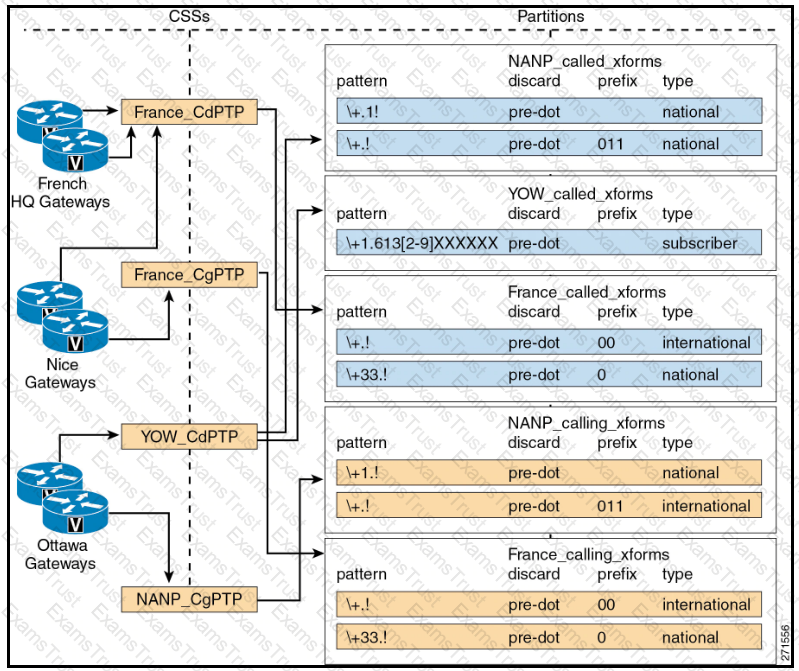
Within the North American Numbering Plan, gateways located in Ottawa, Canada and marked as “YOW” are assigned to the Calling Party Transformation CSS NANP_CgPTP, which contains partition NANP_calling_xforms. What is the calling-party number and the numbering type if the calling user +1613-555-1234 dials the number?
An engineer is configuring a Cisco UCM solution. The requirements state that some users in one location will receive calls from a number during work hours 09AM to 5PM, and another group will get the calls from the same number outside this defined timeslot. Users will also change the outgoing number when reaching out to customers based on the same time-of-day routing rules. Which feature is needed to allow for this type of configuration?
A support engineer is troubleshooting a voice network. When conducting a search for call setup details related to calling search space issues, which trace files should be investigated?
An administrator discovers that employees are making unauthorized long-distance and international calls from logged-off Extension Mobility phones when the authorized users are away from their desks Which two configurations should the administrator configure in the Cisco UCM to avoid this issue? (Choose two.)
After configuring a Cisco CallManager Express with Cisco Unity Express, inbound calls from the PSTN SIP trunk receive a ring tone for 20 seconds and then a busy signal instead of voicemail. Which configuration fixes this problem?
For s SIP to SIP call flow, when does Cisco Unified Border Element require transcoding resources for DTMF?
A customer reports that outbound calls from Cisco UCM to Cisco Unified Border Element are not getting early media. During troubleshooting, the customer finds that Cisco UCM is sending a delayed offer SIP INVITE. Cisco Unified Border Element responds with a 183 Session Progress with SDP message. However, the customer finds that Cisco UCM does not respond to the 183 messages. Which action must the customer perform to resolve the problem?
Refer to me exhibit.
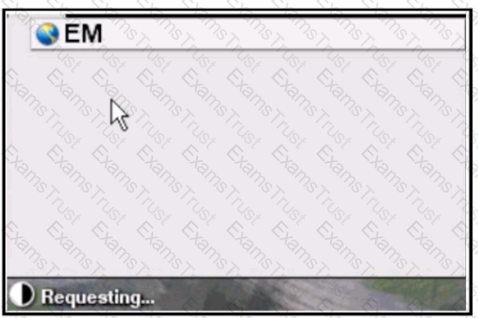
A user cannot access Extension Mobility even after clicking the services button and selecting EM service. There is nowhere to place the username and password to sign In for this service. What Is the cause of the issue?
An administrator is configuring Cisco UCM and wants all inbound calls to the company's published DID number to ring on the receptionist's internal directory number. Which configuration step meets this requirement?
Which description of RTP timestamps or sequence numbers is true?
An administrator is troubleshooting call failures on an H.323 gateway via the CLI. To see signaling for media and call setup, which two debugs must the administrator turn on? (Choose two).
When a third-party SIP Phone System is dialed inbound across a Cisco Unified Border Element, DTMF is failing. The third-party vendor accepts only out-of-band DTMF. Which configuration should be added to the outgoing dial peer to resolve this issue?
A Cisco UCM-based solution uses URI-based calling for Cisco Jabber clients. The solution has several clusters in different locations. The solution being configured must have a secure method o* exchanging addresses between the clusters. Which action ensures that a configuration complies with the requirements?
An administrator is asked to configure egress call routing by applying globalization and localization on Cisco UCM. How should this be accomplished?
Refer to the exhibit.

A collaboration engineer is troubleshooting an issue where external callers cannot leave voicemail messages. Also, internal users report hearing the reorder tone (fast busy) when they attempt to retrieve voicemail messages from their Cisco IP phones. Which action resolves the issue?
A user’s phone is already configured for Single Number Reach, and the user wants a feature to move an active call from a mobile phone to a desk phone and vice-versa. As an administrator, which additional configuration should be made to fulfill the user’s request?
An organization configures a SIP trunk in Cisco UCM to connect to another system. These requirements must be met:
1. Use a specific IP address for SIP signaling.
2. Encrypt the signaling traffic.
3. Restrict which devices can use the SIP trunk. 4 Simplify SIP signaling.
Drag and drop the Cisco UCM configuration steps from the left onto the order on the right to achieve these goals.

Refer to the exhibit.
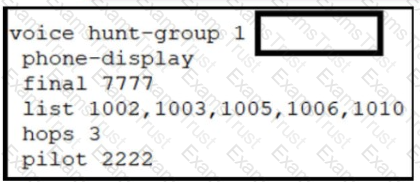
DN 1003 was the last to ring during the most recent call. Which hunting method ensures that DN 1005 is presented with the next call when the hunt pilot is dialed?
Where is the dtmf-relay command configured on Cisco Unified Border Element?
Refer to the exhibit.

Users report that outbound PSTN calls from phones registered to Cisco Unified Communications Manager are not completing. The local service provider in North America has a requirement to receive calls in 10-digit format. The Cisco Unified CM sends the calls to the Cisco Unified Border Element router in a globalized E.164 format. There is an outbound dial peer on Cisco Unified Border Element configured to send the calls to the provider. The dial peer has a voice translation profile applied in the correct direction but an incorrect voice translation rule applied, which is shown in the exhibit. Which rule modified DNIS in the format that the provider is expecting?
End users at a new site report being unable to hear the remote party when calling or being called by users at headquarters. Calls to and from the PSTN work as expected. To investigate the SIP signaling to troubleshoot the problem, which field can provide a hint for troubleshooting?
You see the voice register pool 1 command in your Cisco Unified Communications Manager Express configuration. Which configuration is occurring in this section?

Refer to the exhibit. An engineer deploys CAC to Cisco UCM. UptofiveG.711 calls must be supported on the WAN link between Site A and Site B. Users report that only four concurrent calls are possible between Site A and Site B. Why isn't the filth concurrent call successful?
The SIP session refresh timer allows the RTP session to stay active during an active call. The Cisco UCM sends either SIP-INVITE or SIP-UPDATE messages in a regular interval of time throughout the active duration of the call. During a troubleshooting session, the engineer finds that the Cisco UCM is sending SIP-UPDATE as the SIP session refresher, and the engineer would like to use SIP-INVITE as the session refresher. What configuration should be made in the Cisco UCM to achieve this?
Refer to the exhibit.
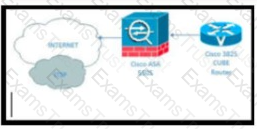
An administrator is troubleshooting a problem in which some outbound calls from an internal network to the Internet telephony service provider are not getting connected, but some others connect successfully. The firewall team found that some call attempts on port 5060 came from an unrecognized IP that has not been defined in the firewall rule. What should the administrator configure in the Cisco Unified Border Element to fix this issue?
Which two statements are correct with respect to the Client Matter Code setting in the route pattern configuration? (Choose two.)
Which call pickup feature allows users to pick up incoming calls in a group that is associated with their own group?
The Cisco Unified Communications Manager Dialed Number Analyzer allows analysis of calls from which two devices? (Choose two.)
A customer routes PSTN calls to ITSP through a SIP trunk on Cisco UCM that forwards and receives calls to and from ITSP. ITSP is set to send an E.164 number when the customer's extension is four digits. Which action should be taken to route the incoming calls to four-digit extensions?
An engineer is configuring a Cisco Collaboration system for SIP endpoints and must enable Survivable Remote Site Telephony for these endpoints. Which code completes this configuration on the SRST gateway?
A)

B)

C)
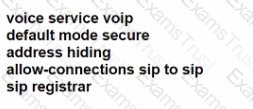
D)

A customer is using a SIP trunk to route calls to ITSP to decrease the possibility of downtime, the customer invested in a failover device How does the customer ensure reachability to ITSP, so that if one device on ITSP fails, the calls will be routed to another device?
Refer to the exhibit.
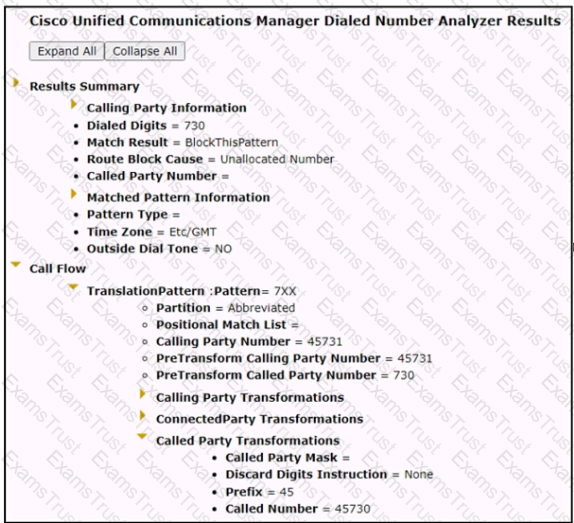
A user cannot call number 730. which Is an abbreviated number for 45730. The engineer recently configured a translation pattern In Cisco UCM. The newly configured translation pattern of 7XX prefixes the digits 45. The engineer uses DNA to troubleshoot the issue. What is the reason for this problem?
Refer to the exhibit.
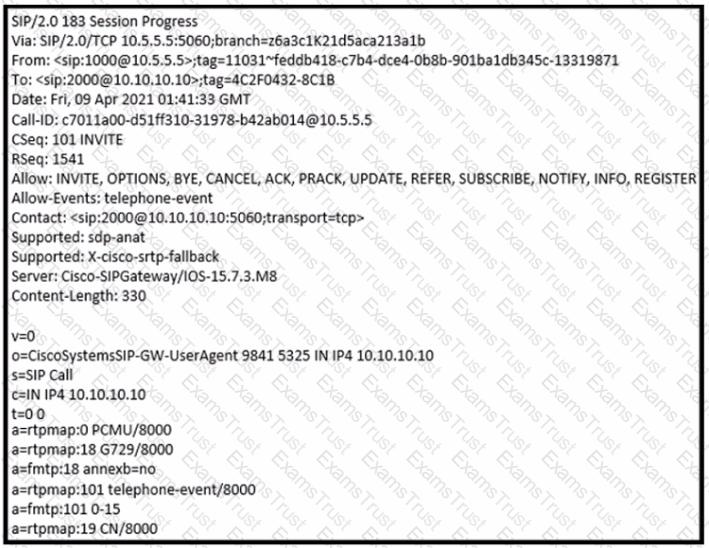
An administrator received reports that users do not hear a ringback when they dial specific external numbers. For example, the Cisco Unified Border Element receives a delayed offer invite from Cisco UCM and responds with the 183 session progress in the exhibit. Assume that the PSTN is responsible for generating ringback in these problematic scenarios. Which action resolves the issue?
Refer to the exhibit.
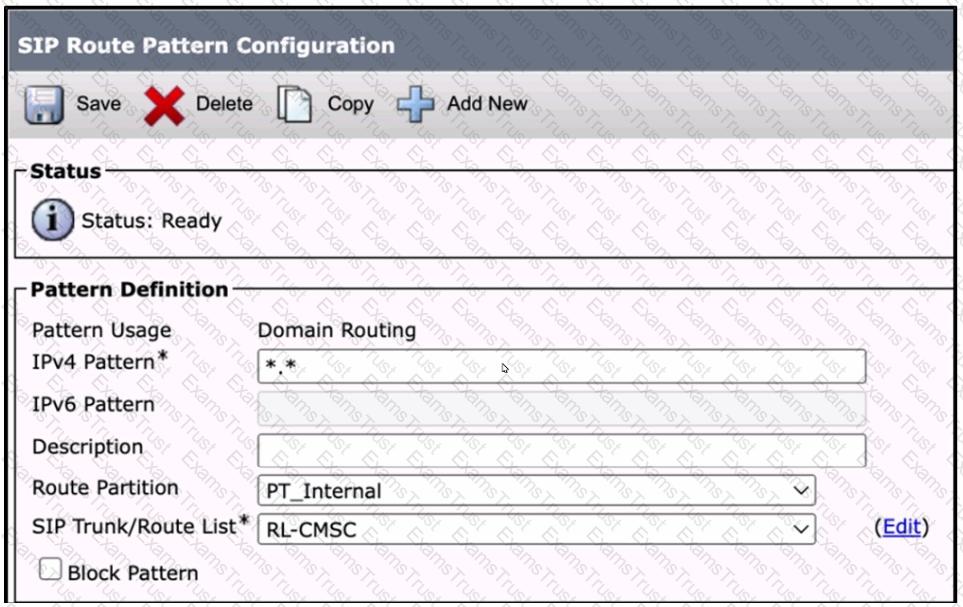
A collaboration engineer investigates an issue where the user calls that match the local Jabber domain are routed back to Cisco UCM. Which action resolves this problem?
A customer wants to configure their team of 10 agents to answer incoming calls to a common central number. The phone for each team member must ring in sequence and ring four times before moving to the next member's phone. Drag and drop the steps from the left into the order on the right to make this happen.
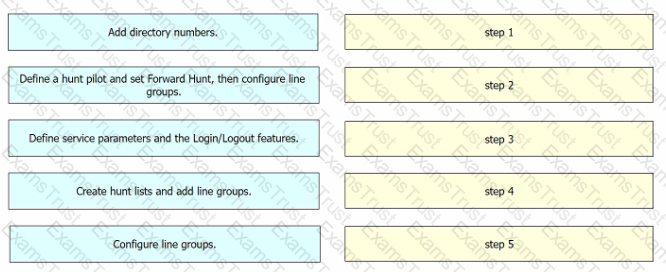
An administrator is configuring an Intercluster Lookup Service between 10 Cisco UCM clusters. Due to security requirements, certificate-based authentication must be used. Due to the deployment size, the administrator wants to avoid manually exchanging certificates between the clusters. Which two steps must be followed to meet these requirements? (Choose two)
A new deployment is using MVA for a specific user on the sales team, but the user is having issues when dialing DTMF. Which DTMF method must be configured in resolve the issue?
Which two types of authentication are supported for the configuration of Intercluster Lookup Service? (Choose two.)
Refer to the exhibit.
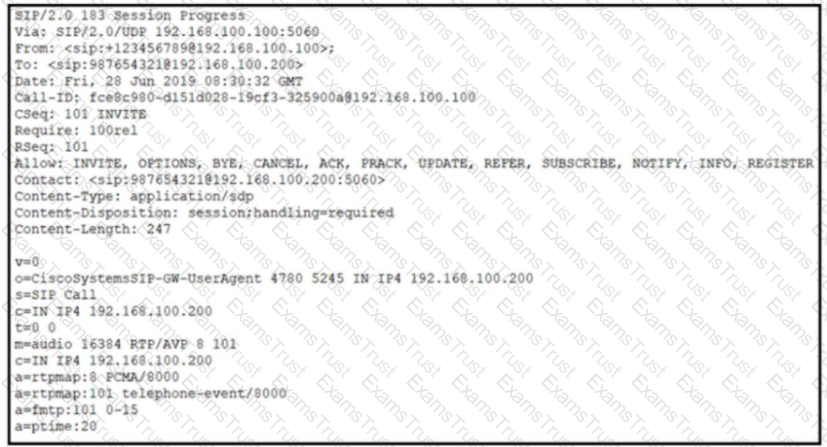
While troubleshooting call failures on the Cisco Unified Border Element, an administrator notices that messages are being sent to the service provider, but there is no response The administrator later learns that this SIP provider does not support PRACK. Which header should be removed from the SIP message to resolve this issue?
An engineer is implementing survivability for a collaboration environment. The environment is utilizing a centralized Cisco UCM at the headquarters and Cisco IOS-XE gateways in the remote branches. Which action must the engineer take to enable both shared lines and B-ACD for SIP branch phones during a WAN outage?
An administrator is configuring Meet-me conferencing in a Cisco UCM deployment and has created the Meet-me number and ensured that it is in a partition accessible by all devices. Which two additional steps must the administrator perform? (Choose two.)
Update the softkey template on all phones to ensure that they contain the Meet-me softkey.
Why would RTP traffic that is sent from the originating endpoint fail to be received on the far endpoint?
Refer to the exhibit.

Users report that when they dial the emergency number 9911 from any internal phone, it takes a long time to connect with the emergency operator. Which action resolves this issue?
Refer to the exhibit.
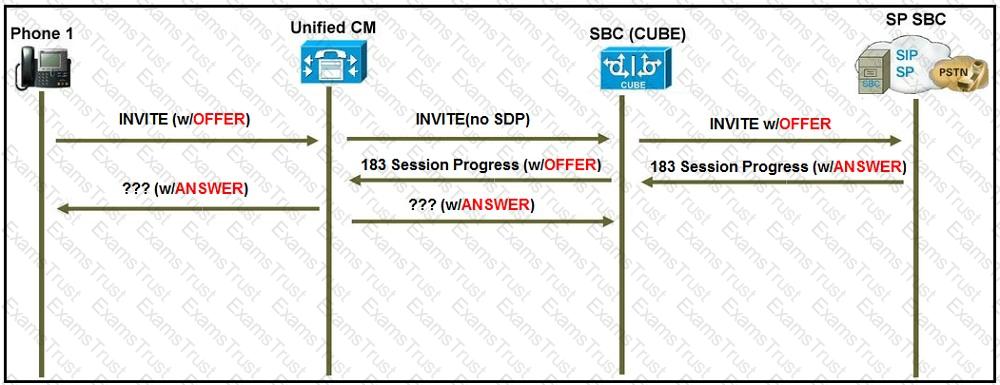
A user reports that when they call a specific phone number, no one answers the call, but when they call from a mobile phone, the call is answered. The engineer troubleshooting the issue is expecting the far-end gateway to cut through audio on the 183 Session Progress SIP message. Which SIP Profile configuration element is necessary for the Cisco Unified Communications Manager to send acknowledgement of provisional responses?
Refer to the exhibit.
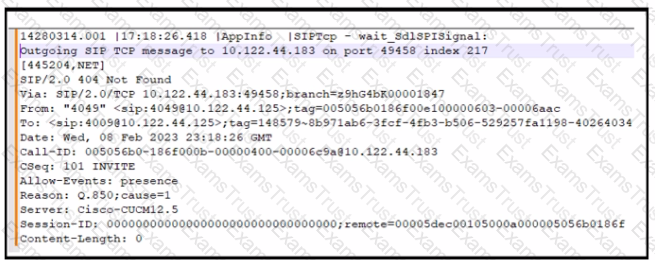
An administrator just upgraded to Cisco UCM to version 14 and started SIP implementation with some new SIP trunks. During the testing, an error was reported when making a call. Which action resolves the issue?
Which two extended capabilities must be configured on dial peers for fast start-to-early media scenarios
(H.323 to SIP interworking)? (Choose two.)
Refer to the exhibit.
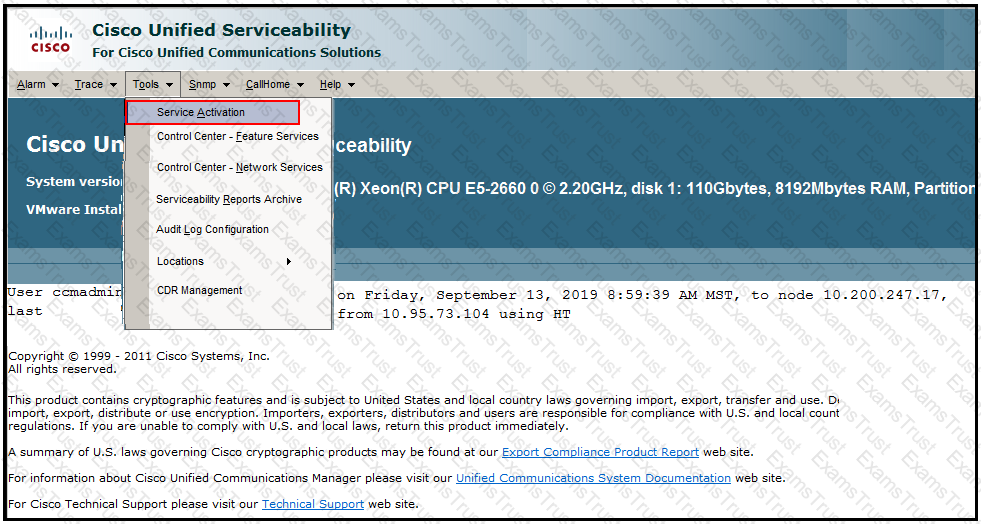
An administrator is troubleshooting a situation where a call placed from a phone registered to Cisco Unified Communications Manager does not complete. The administrator wants to use the Dialed Number Analyzer on Cisco Unified CM to check which translation pattern the call is matching. However, when logging in to Cisco Unified Serviceability there is no option for Dialed Number Analyzer under the tool menu. Which two steps must be performed to resolve this issue? (Choose two.)